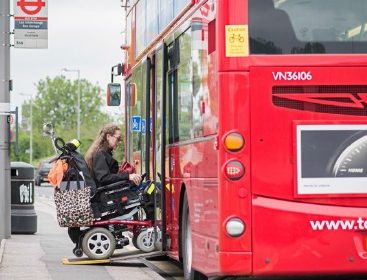TfL has a strategic responsibility for all transport in London. It is the Highway Authority for the capital’s busiest and most important roads with specific powers to ensure the free flow of traffic on the Strategic Road Network.
TfL recognise the role of transport in improving health, which is reflected in our strategic goals and business plans. In particular, the importance of the walking and cycling people do as part of their everyday routine, as they deliver economic and social benefits by keeping people active and healthy.
Every day in London, approximately 1.3 million journeys are made by customers with disabilities; 700,000 journeys are made by people over 75; 5,000,000 journeys are made by passengers carrying heavy luggage, and 1,500,000 by people with small children. Ensuring that the bus network continues to be accessible for all Londoners is critical for London’s future economic prosperity and social inclusion.
There are many different user groups who have different needs with regard to bus stop design and location. Specific user groups that need further consideration include those using wheelchairs, have limited mobility, are visually impaired and/ or the elderly. TfL has guidance in place that recommends bus stop location and specific requirements including:
- Driver and waiting passengers are clearly visible to each other
- Located close to key local facilities
- Located to minimise walking distance between interchange stops
- If temporary bus stops are provided due to necessary suspensions of stops, they are to be located as close as possible to the permanent stop
- Adequate kerb height to allow comfort and ease to step on and off the bus, and for the wheelchair accessible ramps to be deployed correctly.
Balancing development construction requirements and local needs
A Faith Dean development site near Ilford town centre required two bus stops located outside its site to be closed to facilitate works for the duration of the programme. These are strategic bus stops that supply access to the town centre and loss of such facilities would cause long walks to the nearest bus stops. The repercussions could cause some people to avoid using the bus and not visit the town centre.
As per TfL bus stop guidance, a survey took place to source an alternative location near to the permanent bus stops. Unfortunately, efforts were hampered by inadequate space to facilitate the two stops. The one location that would have met the desired criteria had insufficient kerb height to enable the required access arrangements.
TfL, the London Borough of Redbridge and Faith Dean met to investigate all opportunities that could maintain access. The concept of a temporary platform was discussed and agreed. Faith Dean then liaised with a number of companies to see what methods were available. Rediweld (traffic products supplier) were chosen who designed, constructed (using composite materials) and installed the platform.
The bus stop platform has received positive feedback and has been maintaining all-inclusive access for customers whilst enabling the contractor to continue with their programme.
Did you find this article helpful?
Please rate this article

Loading...







